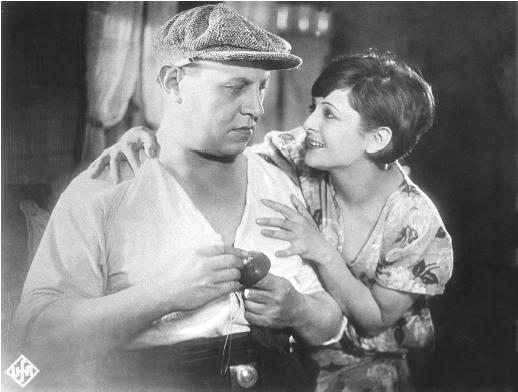VARIETE - Film (Movie) Plot and Review
(Variety)
Germany, 1925
Director: E. A. Dupont
Production: Universum-Film-Aktiengesellschaft (Ufa); black and white, 35mm, silent; length: 2844 meters.
Producer: Erich Pommer; screenplay: Leo Birinski and E. A. Dupont, from the novel Der Eid des Stefan Huller by Felix Holländer;
photography: Karl Freund; production designer: Oscar F. Werndorff; music: Ernö Rappdée.
Cast:
Emil Jannings (
Boss Huller
); Lya de Putti (
Berthe-Marie
); Warwick Ward (
Artinelli
); Maly Delschaft (
Boss's wife
); Georg John (
Sailor
); Kurt Gerron (
Docker
); Paul Rehkopf; Charles Lincoln (
Actor
).
Publications
Books:
Mitry, Jean, Emil Jannings , Paris, 1927.
Moussinac, Leon, Panoramique du Cinéma , Paris, 1929.
Jacobs, Lewis, The Rise of the American Film , New York, 1939.
Kracauer, Siegfried, From Caligari to Hitler: A Psychological History of the German Film , Princeton, 1947.
Arnheim Rudolf, Film as Art , Berkeley, 1957.
Eisner, Lotte, The Haunted Screen , Berkeley, 1969.
Manvell, Roger, and Heinrich Fraenkel, The German Cinema , New York, 1971.
Klinowski, Jacek, and Adam Garbicz, editors, Cinema, The Magic Vehicle: A Guide to Its Achievement: Journey One: The Cinema Through 1949 , Metuchen, New Jersey, 1975.
Monaco, Paul, Cinema and Society: France and Germany during the Twenties , New York, 1976.
Bretschneider, Jürgen, Ewald André Dupont: Autor und Regisseur , Munich, 1992.
Articles:
New York Times , 28 June 1926.
Variety (New York), 30 June 1926.
New Republic (New York), 28 July 1926.
Leprohon, Pierre, "Le Cinéma allemand," in Rouge et le Noir (Paris), July 1928.
Potamkin, Harry, "The Rise and Fall of the German Film," in Cinema , April 1930.
Crisler, B. C., "The Friendly Mr. Freund," in New York Times , 21 November 1937.
Luft, Herbert, "Karl Freund," in Films in Review (New York), February 1963.
Deschner, Donald, "Karl Freund," in Cinema (Beverley Hills), no. 4, 1969.
Truscott, Harold, "Emil Jannings—A Personal View," in Silent Picture (London), Autumn 1970.
Luft, Herbert, "E. A. Dupont, 1891–1956," in Anthologie du Cinéma 6 , Paris, 1971.
Combs, Richard, in Monthly Film Bulletin (London), July 1979.
Magill's Survey of Cinema: Silent Films , Englewood Cliffs, New Jersey, 1982.
* * *
Variety is one of the most significant films of the silent era, a work of technical expertise that liberated the stationary camera. It is

The storyline of Variety is standard: on one level, the film is just a predictable melodrama, with characters who are more types than three-dimensional personalities. Middle-aged trapeze artist Emil Jannings leaves wife and child for a younger woman. He is cuckolded and later jailed for murdering her lover. The scenario unravels in flashback, as Jannings tells the warden his tragedy. (This character is a sexual victim, a fate shared by Professor Unrath in The Blue Angel and August Schiller in The Way of All Flesh —roles also played by Jannings.)
In Variety , the ordinary becomes the extraordinary in that the film is a technical tour de force, highlighted by exceptional editing and unusually striking camera movements and angles. Cinematographer Karl Freund's camera is flexible. He even sets it on a trapeze, photographing from a swinging position the actors' expressions of feelings. The camera becomes the conscience of the characters, who exist in a world of phoney glamor, two-bit circuses and decadent music halls, and, finally, in the case of Jannings, a cheerless prison. As the scenario unravels, the cutting from shot to shot suggests the changes in their points of view.
There is also a superior use of subjective camera, allowing the audience to be involved in the action. As an acrobat plunges to his death, the camera drops from a high wire directly into the faces of the collectively frightened members of the audience. Dramatic tension is enhanced by low-angle shots, and multiple exposures.
While directing a season of vaudeville in Mannheim, E. A. Dupont was summoned by Erich Pommer to the UFA studio to direct Variety. Originally, F. W. Murnau was set to make the film but, according to Freund, Pommer felt he lacked the appropriate passion for the project. Dupont had originally wanted to shoot the film utilizing mostly compositional shots; it was Freund's input that convinced the filmmaker to perfect the method that made Variety so extraordinary. In this regard, Variety is as much a work of art by Karl Freund as E. A. Dupont. The cinematographer was a master of lighting and movement: he had also shot The Last Laugh for Murnau (also starring Jannings), Metropolis for Fritz Lang, and later such Hollywood classics as Dracula, Camille, The Good Earth, Pride and Prejudice , and Key Largo. Variety breaks away from the Expressionist cinema then popular in Germany, and can be seen as the official starting point of an era that became increasingly characterized by realism. But the characters still exist in a quite unreal environment. The film is a psychological drama, with action based not on externals but thoughts and feelings.
Variety was an international hit; particularly in the United States, the film was both a critical and commercial smash. Most significant of all, it served as a model for an entire generation of filmmakers.
—Rob Edelman
Comment about this article, ask questions, or add new information about this topic: